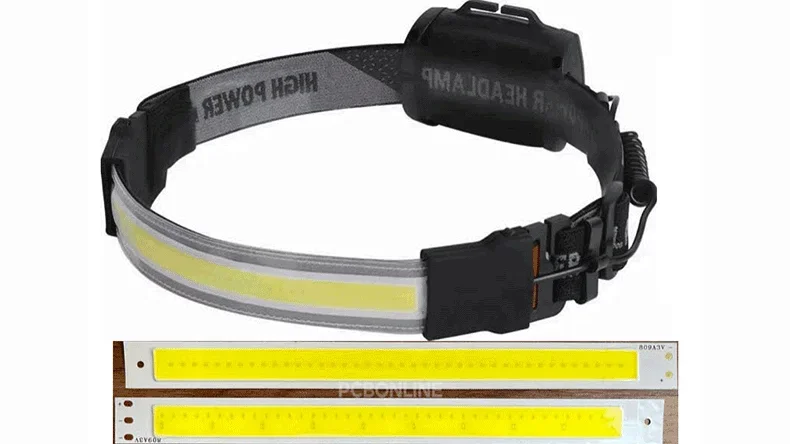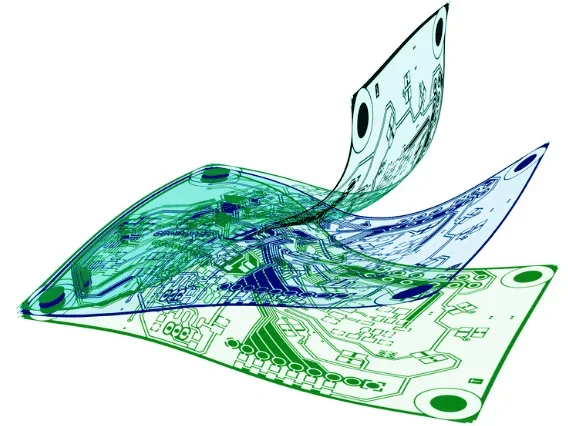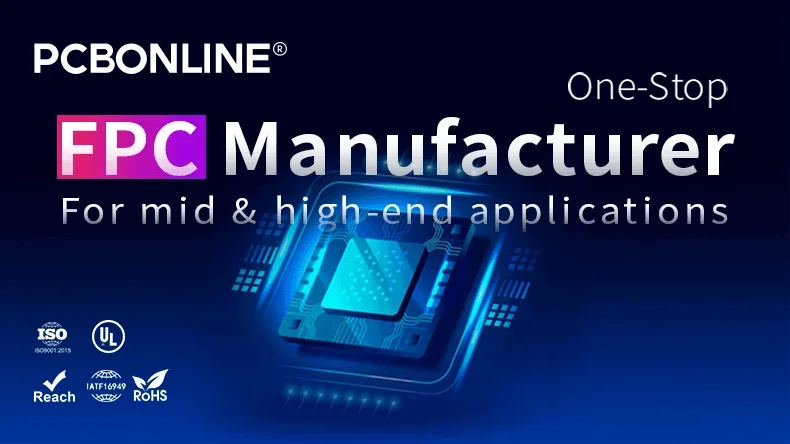
Unlike rigid circuit boards, flexible PCBs or FPCs bend, twist, and fold, but excessive bending can snap a trace or ruin the circuit. That is where the bend radius comes in. It is the minimum amount a flex PCB can bend before it gets damaged.
In this blog, we will break down what flex PCB bend radius is, how to calculate it, and why static and dynamic applications require different approaches.
In this article:
Part 1. What is Flex PCB Bend Radius? Part 2. How to Calculate Flex PCB Bend Radius Part 3. Flex PCB Bend Radius for Static vs. Dynamic Applications Part 4. Flex PCB Material Thickness Corresponding Bend Radius Part 5. One-stop Flexible PCB and PCBA Manufacturer PCBONLINEWhat is Flex PCB Bend Radius?
TThink of a flex PCB like a thin metal wire. Bend it gently, and it holds up fine. Bend it too much, and it cracks, weakens, or snaps. That is exactly what happens with the copper traces inside a flex PCB if they’re bent past their limit. The limit of the bending is defined by Flex PCB radius, i.e. it is the minimum radius to which a flex PCB can be bent without causing damage to the circuitry or board.
To avoid PCB failure, follow these bend radius rules:
- 10× thickness for static flex PCBs
- 100× thickness for dynamic flex PCBs
Consider choosing RA or ED copper for different flex PCB bend radius. Use RA copper for anything that bends frequently. ED copper is fine if the PCB only bends once.
Defining the bend radius in flex PCB design is important because it helps avoid:
- Cracked copper traces, which kill your circuit
- Mechanical stress, shortening PCB life
- Signal loss, making devices unreliable
- Layer separation (delamination), causing permanent damage
What Affects Bend Radius?
If you want your flex PCB to last, you need to consider the following:
- Copper type: Rolled Annealed (RA) copper is great for bending over and over, while Electrodeposited (ED) copper is stiff and works best for PCBs that will not flex again after installation.
- Copper thickness: Thicker copper layers mean a larger bend radius. No way around it.
- Polyimide (PI) or polyester (PET) thickness: The thicker the PI insulation, the stiffer the PCB.
- Application: Static PCBs bend once, and dynamic ones bend constantly.
- Stretching limits: If a material stretches too much, it breaks. That's why we calculate bend radius using elongation percentages.
How to Calculate Flex PCB Bend Radius
There is a simple formula to calculate the bend radius. Industry experts follow IPC-2223 guidelines, which say the bend radius depends on PCB thickness:
R = T × N
Where:
- R = Minimum bend radius
- T = Thickness of the flex PCB (Copper + PI)
- N = Ratio based on PCB type and use
Bend Radius Ratios (from IPC-2223)
|
PCB Type
|
Static Ratio (N)
|
Dynamic Ratio (N)
|
|
Single-layer
|
10:1
|
100:1
|
How RA and ED copper handle bending:
Elongation is the ability of the flex PCB material to stretch or deform before breaking. In flexible PCBs, ED copper has a lower elongation compared to RA copper.
- RA copper (static use) → Max elongation: 16%
- ED copper (static use) → Max elongation: 11%
- RA copper (dynamic use) → Min elongation: 10%
Flex PCB Bend Radius for Static vs. Dynamic Applications
Flexible PCBs can be used in dynamic applications like folding-screen smartphones and bending connection of laptops, and static applications like automotive taillights and cell contact systems in electric vehicle battery packs. For static and dynamic working environments, the bending requirements for the flexible PCBs are different.
FPC Bend Radius for Static Applications (Bent Once, stays in place)
Some flex PCBs are only bent one time during assembly and never move again. These are called static flex PCBs. The static applications of flex PCBs include:
- Laptop hinges (hidden under the keyboard)
- Camera modules (thin cables connecting the sensor)
- Car dashboards (wiring for touchscreens)
- Medical equipment (flexible sensors, display connections)
For single-layer static PCBs, the bend radius must be at least 10× the PCB thickness.
If your flex PCB is 0.2 mm thick:
Rstatic = 0.2 × 10 = 2.0mm
Both RA and ED copper work for flexible PCBs for static applications.
FPC Bend Radius for Dynamic Applications (Bent Over and Over)
Other flex PCBs bend thousands—or even millions—of times. These are dynamic flex PCBs, used in devices where movement is constant. The dynamic applications of flex PCBs include:
- Foldable phones (like Huawei Triple Fold Mate XT)
- Robotic arms (like factories and medical robots)
- Wearable electronics (such as smartwatches, and fitness bands)
- Flexible medical invasive instruments (like gastroscopes and endoscopes)
For single-layer dynamic PCBs, the bend radius must be at least 100× the PCB thickness.
If your PCB is 0.2 mm thick:
Rdynamic = 0.2 × 100 = 20.0mm
So if you're designing a flex PCB that bends frequently, it must have a much larger bend radius, or it will break over time.
Only RA copper should be used in dynamic applications because ED copper is too brittle.
Flex PCB Material Thickness Corresponding Bend Radius
Here's a table from PCBONLINE to help choose the right thickness for your design.
|
Copper
|
PI
|
Total Thickness
|
Min Static Bend (10:1)
|
Min Dynamic Bend (100:1)
|
|
18 µm
|
25 µm
|
0.043 mm
|
0.43 mm
|
4.3 mm
|
|
35 µm
|
50 µm
|
0.085 mm
|
0.85 mm
|
8.5 mm
|
|
70 µm
|
75 µm
|
0.145 mm
|
1.45 mm
|
14.5 mm
|
|
105 µm
|
100 µm
|
0.205 mm
|
2.05 mm
|
20.5 mm
|
This table gives you a quick way to figure out the minimum safe bend radius based on how thick the flex PCB is. Thicker copper and PI layers make the PCB stiffer, so it needs a bigger bend radius to keep from breaking.

If the PCB is only bent once and stays that way (static use), the bend radius should be at least 10 times its thickness. But if it bends over and over (dynamic use), it needs to be 100 times the thickness to stop cracks and wear over time.
Picking the right materials is key—get it wrong, and your PCB won't last.
Other FPC Design Considerations
Besides the flex PCB bend radius, in your FPC design, also consider these important factors and ask the experienced FPC manufacturer PCBONLINE for any assistance.
- Copper weight vs. thickness – Copper is often measured in ounces per square foot rather than thickness (µm).
- Flex cycle life – If your PCB needs to bend millions of times, be extra conservative with the bend radius.
- Extreme temperatures – Heat makes PCBs more flexible, but cold makes them brittle.
- Neutral bend axis – In multi-layer flex PCBs, traces should be aligned near the center to reduce stress.
For flexible PCBs, the common copper weights are:
- 1/2 oz (18 µm)
- 1 oz (35 µm)
- 2 oz (70 µm)
After the flex PCB design and validation, test prototypes in actual conditions to ensure your design holds up. The one-stop flexible PCB manufacturer PCBONLINE can help your R&D and fabricates and tests from prototypes to massive production.
One-stop Flexible PCB and PCBA Manufacturer PCBONLINE
If you're looking for flex PCB R&D and one-stop electronics manufacturing, work with the EMS (electronics manufacturing service) flexible PCB manufacturer PCBONLINE is ready to help. Founded in 1999, PCBONLINE has two large advanced PCB manufacturing bases, one PCB assembly factory, stable supply chains, and an R&D team.

PCBONLINE has turnkey flexible PCB manufacturing capabilities. It not only fabricates and assembles flexible PCBs, but also provides flexible copper-clad laminates custom for flexible PCB fabrication.
PCBONLINE has flex project R&D capabilities and can do the flexible PCB design or take part in your project's development from the early stage.
Strong flexible PCB manufacturing capabilities, including transparent PET flexible PCBs and 1 to 8-layer PI flexible PCBs with a maximum length of 200m.
PCBONLINE provides free design for manufacturing (DFM) and one-on-one engineering support for flexible PCB and PCBA projects.
After flex PCB manufacturing, PCBONLINE does comprehensive tests to ensure the bend radius qualifies for use, such as the tension test, bending test, button strike life test, hand sweat test, environmental protection test, metallographic microscope inspection, bridge test, etc.
High-quality flexible PCBs certified with ISO 9001:2015, ISO 14001:2015, IATF 16949:2016, RoHS, REACH, UL, and IPC-A-610 Class 2/3.
The professional team at PCBONLINE specializes in creating high-quality flexible PCBs and PCBAs tailored to your project's custom needs. To get a quote for your flexible PCBs, please contact info@pcbonline.com.
Conclusion
A proper bend radius is important for flexible PCB design, which avoids cracks, layers peeling apart, and circuit failure—especially in dynamic applications. To design and manufacture flexible PCBs with a proper bending radius for your project, work with PCBONLINE.




